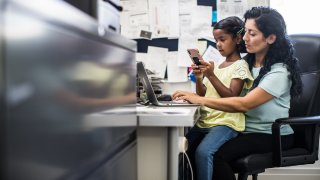
At Michigan State University, children of employees can spend Thursday seeing what it's like to staff a dairy farm, work in sports or plant a tree at the school's first in-person Take Our Kids to Work Day since the pandemic began.
Some 1,500 employees and kids have registered and the university has invited staff to bring any child in their life to explore the campus.
“This is a way that people can see each other and meet their families, show off MSU, which is designated a family friendly university," said Jaimie Hutchison, director of the university’s WorkLife Office. "It also allows people to see what others do across campus and have more pride in the institution that they work for.”
MSU's plans recall the roots of Take Our Kids to Work Day, which celebrates its 30th anniversary on Thursday. However, much has changed since then.
Get Boston local news, weather forecasts, lifestyle and entertainment stories to your inbox. Sign up for NBC Boston’s newsletters.
The idea of Take Our Kids to Work Day seemed like part of a bygone era in recent years because, due to the pandemic, there weren't a lot of workplaces to take them.
Many parents were always taking their kids to work — or taking their work to wherever the kids were — in the dawn of the work-from-home era caused by COVID-19. And for parents who needed to head to a workplace, precautions over limiting the spread of the disease generally kept their kids away.
This year, though, The Take Our Daughters And Sons To Work Foundation, the nonprofit that promotes the day, hopes to remind people of the importance of showing kids where their parents work. The foundation also hopes to get some help to ensure its survival.
U.S. & World
The foundation, which marks the day annually on the third Thursday in April, was led for years by Carolyn McKecuen, an entrepreneur, artist and MacArthur Fellow, who Dave Oliveria, the foundation’s interim executive director, called the linchpin of the organization. She died in November.
“The board is trying to pick up the pieces to just keep it going,” Oliveria said. The foundation lost money last year and currently has no employees.
This year, it is partnering with Junior Achievement USA to host a virtual event that will include a gameshow format where panelists will answer questions about their careers.
In the costal town of Brigantine, New Jersey, school superintendent Glenn Robbins is encouraging his staff to bring their children to school and for students to accompany their parents to their workplaces Thursday. He estimates that around 30% of students will participate.
“It makes them appreciate things that they might not see when they’re stuck in a school building every day for five days a week,” he said.
Over the years, educators and schools have complained that having some students taken out of class is more disruptive than helpful.
Thirty years ago, the head of the Ms. Foundation for Women, Marie Wilson, was inspired by research into the flagging self-esteem of girls when they reached adolescence to suggest that parents bring their daughters to work to expand their sense of possibility.
The foundation’s cofounder, Gloria Steinem, mentioned the idea in an interview and in the spring of 1993, “Take Our Daughters to Work” day exploded into reality.
“It challenged the workplace to be responsive to the family needs in some ways, even making people aware that many people had children at home,” said Teresa Younger, president and CEO of the Ms. Foundation for Women.
Women’s participation in the work force has been largely flat since 2000, after picking up in the 1990s. About three-quarters of women aged 25 through 54, a group that filters out students and retirees, were in the workforce in 1993, a figure that reached nearly 78% this year, according to the Bureau of Labor Statistics. The pandemic disproportionally drove women out of the workforce and they returned more slowly even after lockdown measures ended and available jobs again increased.
The name and date of the day has changed since it started, including boys officially in 2003, though many workplaces have used “kid” or “child” for years. Also, companies and workplaces are free to organize a day for employees to bring their children to work whenever and however they like, said Oliveria.
Around 1,000 kids have registered for this year's livestream, Junior Achievement US said. But it has always been difficult to measure participation, Oliveria said, but this year's participation likely represents a sharp decline from the 18 million kids that the organization said participated between 2005 and 2009.
“I don’t see evidence of a million people, but I think that many companies can do their own thing and we wouldn’t know,” Oliveria said. “That’s just a tough thing to put your arms around.”
Younger said she understands the difficulty of continuing to meet the needs of the current moment.
“That’s the challenge of every legacy organization, is: how do we respond to the challenges of now and continue to integrate the work as it needs to be?” she asked.
Bringing a child to work is still a meaningful way to create a more economically and socially equitable society, she said. “It holds industry accountable for the opportunities that they provide for the next generation and the exposure they provide.”



